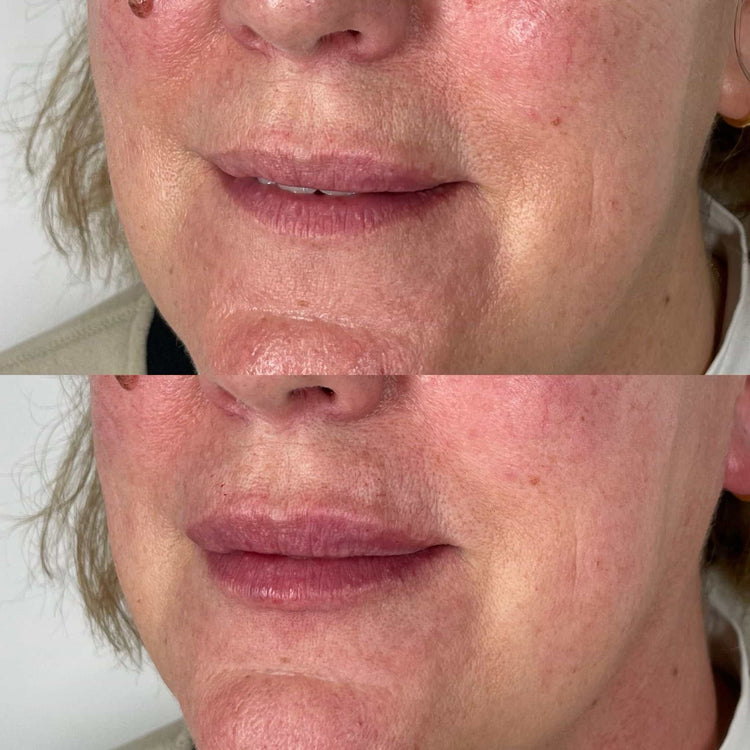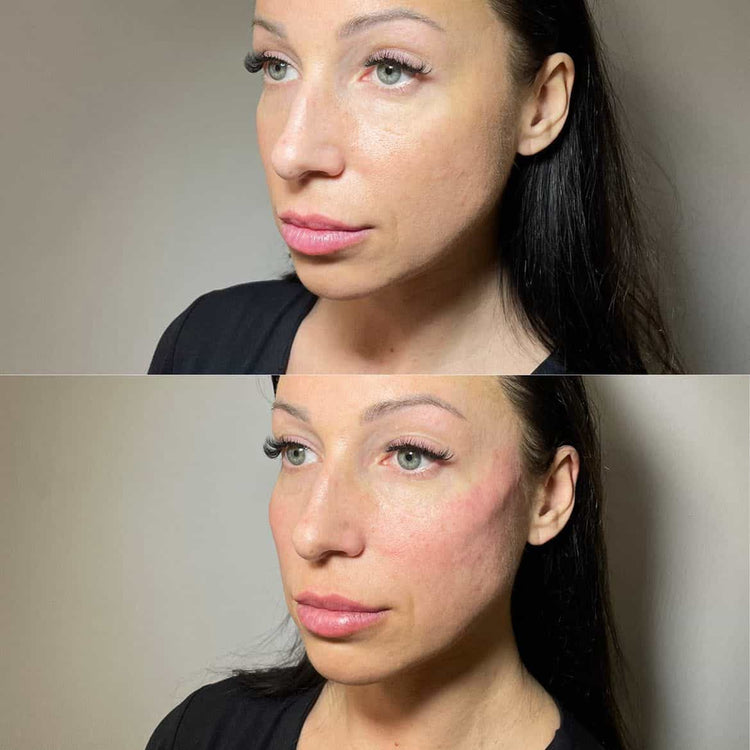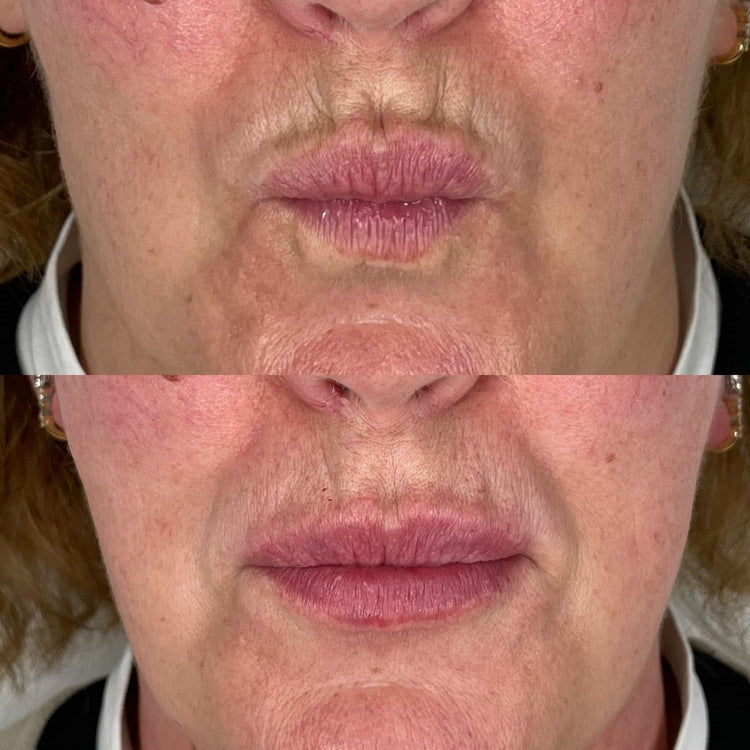Dermal Fillers Vs Botox In The UK: Key Differences
What are dermal fillers?

Dermal fillers are gel-like substances injected under the skin to add volume, smooth wrinkles, or enhance facial contours.
These fillers typically contain hyaluronic acid, a naturally occurring substance in the body that helps retain moisture and provide fullness.
They can be used to address a variety of cosmetic concerns, such as wrinkles around the mouth, cheeks hollows, thin lips, and under-eye bags. The results of dermal filler treatment are usually temporary, lasting anywhere from 6 months to 2 years depending on the type of filler used.
Types of dermal fillers
There are several types of dermal fillers available in the UK.
- Hyaluronic acid fillers
- Calcium hydroxylapatite fillers
- Poly-L-lactic acid (PLLA) fillers
- Polymethylmethacrylate (PMMA) fillers
Uses of dermal fillers
Dermal fillers are gel-like substances injected under the skin to add volume, smooth wrinkles, or enhance facial contours. These fillers typically contain hyaluronic acid, a naturally occurring substance in the body that helps retain moisture and provide fullness. They can be used to address a variety of cosmetic concerns, such as wrinkles around the mouth, cheek hollows, thin lips, and under-eye bags. The results of dermal filler treatment are usually temporary, lasting anywhere from 6 months to 2 years depending on the type of filler used.
There are several types of dermal fillers available in the UK:
- Hyaluronic acid fillers
- Calcium hydroxylapatite fillers
- Poly-L-lactic acid (PLLA) fillers
- Polymethylmethacrylate (PMMA) fillers
What is Botox?
%h2% What is Botox?
Botox is a neurotoxin produced by the bacterium Clostridium botulinum. It works by blocking nerve signals to muscles, temporarily paralyzing them. When injected into facial muscles, Botox can reduce the appearance of wrinkles and fine lines by preventing muscle contractions that cause them.
How does Botox work?
Botox is a neurotoxin produced by the bacterium Clostridium botulinum. It works by blocking nerve signals to muscles, temporarily paralyzing them. When injected into facial muscles, Botox can reduce the appearance of wrinkles and fine lines by preventing muscle contractions that cause them.
Uses of Botox
What is Botox?
Botox is a neurotoxin produced by the bacterium Clostridium botulinum. It works by blocking nerve signals to muscles, temporarily paralyzing them. When injected into facial muscles, Botox can reduce the appearance of wrinkles and fine lines by preventing muscle contractions that cause them.
Comparing Dermal Fillers and Botox
In the realm of cosmetic enhancement, dermal fillers and Botox have emerged as popular choices for addressing signs of aging. Dermal fillers, typically containing hyaluronic acid, are used to add volume and smooth wrinkles, while Botox, a neurotoxin derived from bacteria, temporarily paralyzes muscles to reduce the appearance of fine lines.
Duration of Results
Dermal fillers and Botox both address facial aging but work in different ways.
Dermal fillers are designed to plump up areas that have lost volume due to age. They add substance beneath the skin, smoothing wrinkles and enhancing contours like cheeks, lips, and under-eye hollows. These results typically last anywhere from 6 months to 2 years, depending on the type of filler used.
Botox, on the other hand, works by temporarily paralyzing muscles responsible for dynamic wrinkles – lines that appear when you make facial expressions. It prevents muscle contractions that lead to these wrinkles, smoothing them out. The effects of Botox typically last around 3-6 months, requiring repeat injections to maintain results.

Treatment Process
Dermal fillers and Botox both address facial aging but work in different ways.
Dermal fillers are designed to plump up areas that have lost volume due to age. They add substance beneath the skin, smoothing wrinkles and enhancing contours like cheeks, lips, and under-eye hollows. These results typically last anywhere from 6 months to 2 years, depending on the type of filler used.
Botox, on the other hand, works by temporarily paralyzing muscles responsible for dynamic wrinkles – lines that appear when you make facial expressions. It prevents muscle contractions that lead to these wrinkles, smoothing them out. The effects of Botox typically last around 3-6 months, requiring repeat injections to maintain results.
Risks and Side Effects
Dermal fillers and Botox are both popular non-surgical cosmetic treatments used to address signs of aging.
While they both aim to improve facial appearance, they work in different ways.
Dermal fillers, typically containing hyaluronic acid, are injected beneath the skin to add volume and plump up areas that have lost fullness due to age. This can smooth wrinkles, enhance contours like cheeks and lips, and reduce the appearance of hollows under the eyes. The results of dermal filler treatments are generally temporary, lasting anywhere from 6 months to 2 years.

Botox, on the other hand, is a neurotoxin that temporarily paralyzes muscles. When injected into facial muscles, it prevents them from contracting, which reduces the appearance of dynamic wrinkles – those lines that form when you smile, frown, or make other facial expressions. The effects of Botox typically last for 3 to 6 months.
Both dermal fillers and Botox carry potential risks and side effects.
Dermal filler complications can include swelling, bruising, redness, infection, lumps, and vascular occlusion (blockage of blood vessels). It’s crucial to choose a qualified and experienced injector to minimize these risks.
Botox side effects are generally mild and temporary, including pain at the injection site, bruising, drooping eyelids, and headaches. More serious complications, such as muscle weakness or facial asymmetry, are rare but can occur.
Book your wrinkle treatment with Dr. Laura Geige at It’s Me & You Clinic
- The Science Behind The Absorption Of THC In Beverages - May 13, 2025
- How To Sleep After Tear Trough Filler - May 13, 2025
- How Long After Lip Filler Can I Kiss - May 12, 2025

